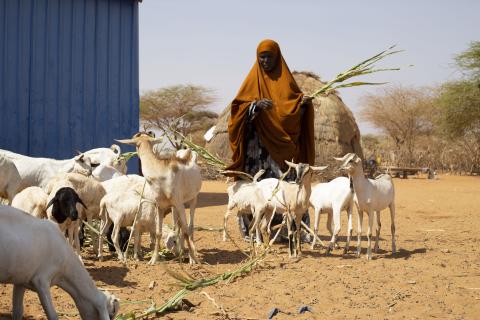Preventing child wasting in Africa’s Dryland through a food systems lens
This is a summary of the following paper: Fracassi P, Daget M, Seo S et al. (2023) Preventing Child Wasting in Africa's Dryland: An Exploratory Review of the Enabling Environment in 8 Sub-Saharan Countries Using a Food Systems Lens. Food and Nutrition Bulletin, 44, 2, S32–S44. https://doi.org/10.1177/03795721231188767
In 2021, two events – the United Nations (UN) Food Systems Summit and the Tokyo Nutrition for Growth Summit – represented a decisive time for the alignment of food systems and nutrition. In a context of persistent child wasting, notably across the Sahel and Horn of Africa, the costed country operational roadmaps, developed in 22 countries as part of the joint UN Global Action Plan (GAP) on Child Wasting, recognised the importance of preventing child wasting using a multisectoral approach.
In this review, authors used a food systems lens to assess how current governance mechanisms, policies, and programming priorities in eight sub-Saharan countries were responsive to the food security and nutritional needs of the most vulnerable people. The eight countries – Burkina Faso, Ethiopia, Kenya, Niger, Nigeria, Mali, South Sudan, and Sudan – were selected because of their commitment to address child wasting using a systemic approach as part of the GAP.
Authors assessed the governance mechanisms through a review of joint annual assessments conducted by the Scaling Up Nutrition movement; the policy frameworks through an analysis of recommendations included in operational roadmaps and findings from the review of national multisectoral nutrition plans; and programming priorities through the analysis of the typologies of costed interventions in the food and social protection systems.
Governance mechanisms: Most fragile and conflict-affected countries had platforms in place that were convened around emergency responses but lacked well-equipped mechanisms to build the humanitarian–development nexus and effectively coordinate preventive actions using a food systems lens. Overall, there was limited evidence that the most vulnerable communities were prioritised through assessments of their context-specific needs and responsive actions to address shortcomings of the food systems as well as environmental, livelihoods, and/or political/conflict drivers.
Policy frameworks: Most recent plans showed a shift in systems thinking by placing sustainable food systems at the core for supporting healthy diets and better nutrition. There was a high level of emphasis on nutritionally vulnerable individuals (young children, adolescents, and women during pregnancy and lactation). Few policy recommendations mentioned other categories of vulnerable individuals such as the poor, internally displaced people, refugees, and people with disabilities.
Programming priorities: In addition to wasting, countries considered factors such as food insecurity, poverty, and vulnerability as criteria for geographic prioritisation. Costed interventions included in the operational roadmaps were aligned with recommendations to orient food systems toward healthier diets. All countries prioritised and costed interventions on nutritious food value chains and social transfers (cash and in-kind). Most countries prioritised food safety, food fortification and biofortification, school food and nutrition, and social protection.
The review revealed common strengths in terms of existing multistakeholder governance mechanisms, opportunities for engaging key actors in the food systems, and existence of policy frameworks. It also revealed that context-specific risks and vulnerabilities linked to livelihoods, environment, and seasonality, as well as political/conflict drivers, could be better incorporated into how policies are enacted and programmes implemented.


 English
English Français
Français Deutsch
Deutsch Italiano
Italiano Español
Español